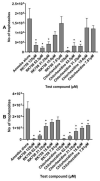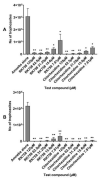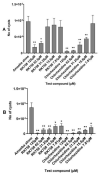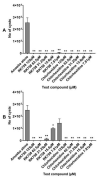The Anti-Amoebic Activity of a Peptidomimetic against Acanthamoeba castellanii
- PMID: 36557630
- PMCID: PMC9782699
- DOI: 10.3390/microorganisms10122377
The Anti-Amoebic Activity of a Peptidomimetic against Acanthamoeba castellanii
Abstract
Acanthamoeba is a free-living protozoan known to cause keratitis most commonly, especially among contact lens wearers. Treatment of Acanthamoeba keratitis is challenging as Acanthamoeba can encyst from the active form, a trophozoite, into a hibernating cyst that is refractory to antibiotics and difficult to kill; therefore, there is a need for more effective anti-amoebic strategies. In this study, we have evaluated the anti-amoebic activity of the antimicrobial peptide mimic RK-758 against Acanthamoeba castellanii. RK-758 peptidomimetic was subjected to biological assays to investigate its amoebicidal, amoebistatic, anti-encystation, and anti-excystation effects on A. castellanii. The anti-amoebic activity of the peptide mimic RK-758 was compared with chlorhexidine against the Acanthamoeba castellanii ATCC30868 and Acanthamoeba castellanii 044 (a clinical strain) with the concentrations of both ranging from 125 µM down to 7.81 µM. All experiments were performed in duplicate with three independent replicates. The data were represented as mean ± SE and analysed using a two-sample t-test and two-tailed distributions. A p < 0.05 was considered statistically significant. The peptidomimetic RK-758 had anti-Acanthamoeba activity against both trophozoites and cysts in a dose-dependent manner. The RK-758 had amoebicidal and growth inhibitory activities of ≥50% at a concentration between 125 µM and 15.6 µM against the trophozoites of both Acanthamoeba strains. Inhibitory effects on the cyst formation and trophozoite re-emergence from cysts were noted at similar concentrations. Chlorhexidine had 50% activity at 7.81 µM and above against the trophozoites and cysts of both strains. In the haemolysis assay, the RK-758 lysed horse RBCs at concentrations greater than 50 µM whereas lysis occurred at concentrations greater than 125 µM for the chlorhexidine. The peptidomimetic RK-758, therefore, has activity against both the trophozoite and cyst forms of Acanthamoeba and has the potential to be further developed as an anti-microbial agent against Acanthamoeba. RK-758 may also have use as an anti-amoebic disinfectant in contact lens solutions.
Keywords: Acanthamoeba; anti-microbial peptides; free-living amoeba; peptidomimetics.
Conflict of interest statement
The authors declare no conflict of interest.
Figures






Similar articles
-
The Activity of Polyhomoarginine against Acanthamoeba castellanii.Biology (Basel). 2022 Nov 28;11(12):1726. doi: 10.3390/biology11121726. Biology (Basel). 2022. PMID: 36552236 Free PMC article.
-
Metformin-coated silver nanoparticles exhibit anti-acanthamoebic activities against both trophozoite and cyst stages.Exp Parasitol. 2020 Aug;215:107915. doi: 10.1016/j.exppara.2020.107915. Epub 2020 May 24. Exp Parasitol. 2020. PMID: 32461112
-
In vitro Evaluation the Efficacy of Some New Plant Extracts and Biocides on the Viability of Acanthamoeba castellanii.Protist. 2023 Jun;174(3):125966. doi: 10.1016/j.protis.2023.125966. Epub 2023 May 9. Protist. 2023. PMID: 37229821
-
Encystment and Excystment Processes in Acanthamoeba castellanii: An Emphasis on Cellulose Involvement.Pathogens. 2025 Mar 10;14(3):268. doi: 10.3390/pathogens14030268. Pathogens. 2025. PMID: 40137753 Free PMC article. Review.
-
Diagnostic Considerations for Non-Acanthamoeba Amoebic Keratitis and Clinical Outcomes.Pathogens. 2022 Feb 8;11(2):219. doi: 10.3390/pathogens11020219. Pathogens. 2022. PMID: 35215164 Free PMC article. Review.
Cited by
-
Cyclic Peptide Natural Product Inspired Inhibitors of the Free-Living Amoeba Balamuthia mandrillaris.J Nat Prod. 2025 Feb 28;88(2):274-281. doi: 10.1021/acs.jnatprod.4c00834. Epub 2025 Feb 13. J Nat Prod. 2025. PMID: 39948695 Free PMC article.
-
Harnessing Non-Antibiotic Strategies to Counter Multidrug-Resistant Clinical Pathogens with Special Reference to Antimicrobial Peptides and Their Coatings.Antibiotics (Basel). 2025 Jan 9;14(1):57. doi: 10.3390/antibiotics14010057. Antibiotics (Basel). 2025. PMID: 39858343 Free PMC article. Review.
References
-
- Carnt N., Hoffman J.M., Verma S., Hau S., Radford C.F., Minassian D.C., Dart J.K.G. Acanthamoeba keratitis: Confirmation of the UK outbreak and a prospective case-control study identifying contributing risk factors. Br. J. Ophthalmol. 2018;102:1621–1628. doi: 10.1136/bjophthalmol-2018-312544. - DOI - PubMed
LinkOut - more resources
Full Text Sources

